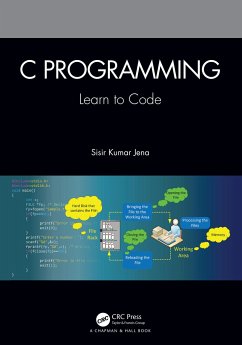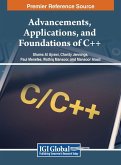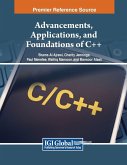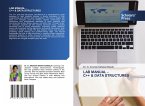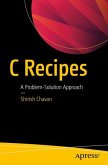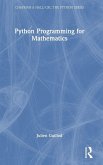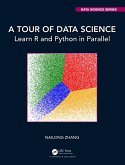- Gebundenes Buch
- Merkliste
- Auf die Merkliste
- Bewerten Bewerten
- Teilen
- Produkt teilen
- Produkterinnerung
- Produkterinnerung
C programming is taught as the primary computer language in almost every university and its affiliated colleges. as it acts as a building block to learn other high-level languages. This book can act as a textbook or a supplementary book that helps the learner understand the subject in greater detail. It can also be used by professionals.
Andere Kunden interessierten sich auch für
![Advancements, Applications, and Foundations of C++ Advancements, Applications, and Foundations of C++]() Shams Al AjrawiAdvancements, Applications, and Foundations of C++264,99 €
Shams Al AjrawiAdvancements, Applications, and Foundations of C++264,99 €![Advancements, Applications, and Foundations of C++ Advancements, Applications, and Foundations of C++]() Shams Al AjrawiAdvancements, Applications, and Foundations of C++201,99 €
Shams Al AjrawiAdvancements, Applications, and Foundations of C++201,99 €![LAB MANUAL - C++ & DATA STRUCTURES LAB MANUAL - C++ & DATA STRUCTURES]() Dr. G. AROCKIA SAHAYA SHEELALAB MANUAL - C++ & DATA STRUCTURES34,99 €
Dr. G. AROCKIA SAHAYA SHEELALAB MANUAL - C++ & DATA STRUCTURES34,99 €![C Recipes C Recipes]() Shirish ChavanC Recipes42,99 €
Shirish ChavanC Recipes42,99 €![Java Programming Exercises Java Programming Exercises]() Christian UllenboomJava Programming Exercises157,99 €
Christian UllenboomJava Programming Exercises157,99 €![Python Programming for Mathematics Python Programming for Mathematics]() Julien GuillodPython Programming for Mathematics158,99 €
Julien GuillodPython Programming for Mathematics158,99 €![A Tour of Data Science A Tour of Data Science]() Nailong ZhangA Tour of Data Science62,99 €
Nailong ZhangA Tour of Data Science62,99 €-
-
-
C programming is taught as the primary computer language in almost every university and its affiliated colleges. as it acts as a building block to learn other high-level languages. This book can act as a textbook or a supplementary book that helps the learner understand the subject in greater detail. It can also be used by professionals.
Produktdetails
- Produktdetails
- Verlag: Chapman and Hall/CRC
- Seitenzahl: 454
- Erscheinungstermin: 29. Dezember 2021
- Englisch
- Abmessung: 260mm x 183mm x 29mm
- Gewicht: 1043g
- ISBN-13: 9781032036250
- ISBN-10: 1032036257
- Artikelnr.: 62234042
- Herstellerkennzeichnung
- Libri GmbH
- Europaallee 1
- 36244 Bad Hersfeld
- gpsr@libri.de
- Verlag: Chapman and Hall/CRC
- Seitenzahl: 454
- Erscheinungstermin: 29. Dezember 2021
- Englisch
- Abmessung: 260mm x 183mm x 29mm
- Gewicht: 1043g
- ISBN-13: 9781032036250
- ISBN-10: 1032036257
- Artikelnr.: 62234042
- Herstellerkennzeichnung
- Libri GmbH
- Europaallee 1
- 36244 Bad Hersfeld
- gpsr@libri.de
Sisir Kumar Jena is presently working as an Assistant Professor in the Department of CSE, DIT University, Dehradun. He was the HOD and Assistant Professor in the Department of CSE at Nalanda Institute of Technology, Bhubaneswar, India, during 2007-2015. He has more than 10 years of teaching experience and five years of experience as a Research Scholar at IIT Guwahati. He is pursuing his Ph.D. in Computer Science and Engineering at IIT, Guwahati, while writing this book. He has published many research papers and book chapters in refereed International Conferences and Journals. His interest area includes Digital VLSI Design and Testing, Approximate Computing, IoT, and Security in Hardware.
1 Introduction to Computer. 1.1 Introduction. 1.2 Definition and
Characteristics of a Computer System. . 1.3. History of Computer. . 1.4
Basic Computer Organization. 1.5 Computer Memory. 1.6 Introduction to
Operating System. 1.7 Review Questions. 2 Number System. 2.1 Introduction.
2.2 Positional Number System. 2.3 Number Conversion. 2.4 Review Questions.
. 3 Problem Solving through Flowchart and Algorithm. 2.1 Introduction. 2.2
Problem Solving Approach. 2.3 Algorithm Design. 2.4 Basics of an Algorithm.
2.5 Flowchart. 2.6 Example Problems. 2.7 Basics of Programming Language.
2.8 Review Questions. . 4 Introduction to C Programming. 4.1 Introduction.
4.2 History of C. 4.3 Executing a C Program. 4.4 Structure of a C Program.
4.5 Compilers and Editors to Execute C Program. 4.6 Review Questions. . 5
Constants, Variables, and Data Types. 5.1 Introduction. 5.2 C Character
Set. 5.3 Keywords. 5.4 Variables and Identifiers. 5.5 Data Types. 5.6
Declaration of Variables. 5.7 Constants. 5.8 Learn to Code Examples. 5.9
Escape Sequences. 5.10 Review Questions. . 6 Operators and Expressions.
6.1 Introduction. 6.2 Arithmetic Operator. 6.3 Relational Operator. 6.4
Assignment Operator. 6.5 Logical Operator. 6.6 Increment and Decrement
Operator. 6.7 Conditional Operator. 6.8 Bitwise Operator. 6.9 Special
Operators. 6.10 Expressions. 6.11 Type Conversion. 6.12 Operator Precedence
and Associativity. 6.13 Review Questions. . 7 Basic Input Output. 7.1
Introduction. 7.2 Unformatted Functions. 7.3 Formatted Functions. 7.4
Review Questions. . 8 Control Structure. 8.1 Introduction. 8.2 Selection
with if statement. 8.3 if-else Statement. 8.4 Nested if-else Statement. 8.5
If-else-if Ladder. 8.6 Compound Statement. 8.7 Multiway Selection with
switch Statement. 8.8 goto Statement . 8.9 Introduction to Looping. 8.10
while Loop. 8.11 do-while Loop. 8.12 for Loop. 8.13 Unconditional
branching: break and continue. 8.14 Review Questions. . 9 Function. 9.1
Introduction. 9.2 Need of functions. 9.3 Types of Function. 9.4 User
Defined Function. 9.5 Component and Working of a Function. 9.6 Categories
of a Function. 9.7 Recursion. 9.8 Storage Classes. 9.9 Review Question. .
10 Arrays and Strings. 10.1 Introduction. 10.2 Need of an Array. 10.3 Types
of Array. 10.4 One Dimensional Array. 10.5 Two Dimensional Array. 10.6
Multidimensional Array. 10.7 Character array: String. 10.8 String
Functions. 10.9 Review Questions. . 11 Pointers. 11.1 Introduction. 11.2
Basic Knowledge. 11.3 Pointer Variable. 11.4 Pointer to Pointer (Double
Pointer). 11.5 Void Pointer. 11.6 Null Pointer. 11.7 Constant Pointer. 11.8
Pointer Arithmetic. 11.9 Pointers and Functions. 11.10 Pointers and Arrays.
11.11 Passing Arrays to Function. 11.12 Pointers and Two Dimensional array.
11.13 Pointer and String. 11.14 Arrays of Pointers. 11.15 Pointers to
Function. 11.16 Review Questions. . 12 Structure and Union. 12.1
Introduction. 12.2 Declaring Structure. 12.3 Initializing structure. 12.4
Accessing Structure elements. 12.5 Learn to Code Examples. 12.6 Array of
Structures. 12.7 Structure within Structure (Nested Structure). 12.8 User
defined Data Type: typedef. 12.9 Pointers and Structures. 12.10 Structure
and Function. 12.11 Unions. 12.12 Structure VS Union. 12.13 Bit Fields.
12.14 Enumeration. 12.15 Review Questions. . 13 Dynamic Memory Allocation.
13.1 Introduction. 13.2 Types of Memory Allocation. 13.3 Dynamic Memory
Allocation Process. 13.4 Review Questions. . 14 File Handling. 14.1
Introduction. 14.2 Basics of File I/O. 14.3 Opening a File. 14.4 Closing a
File. 14.5 File Functions with Examples. 14.6 Review Questions. . 15 The
Preprocessor. 15.1 Introduction. 15.2 Preprocessor Directives. 15.3 Macro
Substitutions. 15.4 #include Preprocessor. 15.5 Conditional Preprocessors.
15.6 Other Preprocessor Directives. 15.7 Review Questions. . 16 Command
Line Arguments. 16.1 Introduction. 16.2 Executing a Program using Command
Prompt. 16.3 Fundamentals of Command Line Argument. 16.4 Using Command Line
Argument. 16.5 Review Questions.
Characteristics of a Computer System. . 1.3. History of Computer. . 1.4
Basic Computer Organization. 1.5 Computer Memory. 1.6 Introduction to
Operating System. 1.7 Review Questions. 2 Number System. 2.1 Introduction.
2.2 Positional Number System. 2.3 Number Conversion. 2.4 Review Questions.
. 3 Problem Solving through Flowchart and Algorithm. 2.1 Introduction. 2.2
Problem Solving Approach. 2.3 Algorithm Design. 2.4 Basics of an Algorithm.
2.5 Flowchart. 2.6 Example Problems. 2.7 Basics of Programming Language.
2.8 Review Questions. . 4 Introduction to C Programming. 4.1 Introduction.
4.2 History of C. 4.3 Executing a C Program. 4.4 Structure of a C Program.
4.5 Compilers and Editors to Execute C Program. 4.6 Review Questions. . 5
Constants, Variables, and Data Types. 5.1 Introduction. 5.2 C Character
Set. 5.3 Keywords. 5.4 Variables and Identifiers. 5.5 Data Types. 5.6
Declaration of Variables. 5.7 Constants. 5.8 Learn to Code Examples. 5.9
Escape Sequences. 5.10 Review Questions. . 6 Operators and Expressions.
6.1 Introduction. 6.2 Arithmetic Operator. 6.3 Relational Operator. 6.4
Assignment Operator. 6.5 Logical Operator. 6.6 Increment and Decrement
Operator. 6.7 Conditional Operator. 6.8 Bitwise Operator. 6.9 Special
Operators. 6.10 Expressions. 6.11 Type Conversion. 6.12 Operator Precedence
and Associativity. 6.13 Review Questions. . 7 Basic Input Output. 7.1
Introduction. 7.2 Unformatted Functions. 7.3 Formatted Functions. 7.4
Review Questions. . 8 Control Structure. 8.1 Introduction. 8.2 Selection
with if statement. 8.3 if-else Statement. 8.4 Nested if-else Statement. 8.5
If-else-if Ladder. 8.6 Compound Statement. 8.7 Multiway Selection with
switch Statement. 8.8 goto Statement . 8.9 Introduction to Looping. 8.10
while Loop. 8.11 do-while Loop. 8.12 for Loop. 8.13 Unconditional
branching: break and continue. 8.14 Review Questions. . 9 Function. 9.1
Introduction. 9.2 Need of functions. 9.3 Types of Function. 9.4 User
Defined Function. 9.5 Component and Working of a Function. 9.6 Categories
of a Function. 9.7 Recursion. 9.8 Storage Classes. 9.9 Review Question. .
10 Arrays and Strings. 10.1 Introduction. 10.2 Need of an Array. 10.3 Types
of Array. 10.4 One Dimensional Array. 10.5 Two Dimensional Array. 10.6
Multidimensional Array. 10.7 Character array: String. 10.8 String
Functions. 10.9 Review Questions. . 11 Pointers. 11.1 Introduction. 11.2
Basic Knowledge. 11.3 Pointer Variable. 11.4 Pointer to Pointer (Double
Pointer). 11.5 Void Pointer. 11.6 Null Pointer. 11.7 Constant Pointer. 11.8
Pointer Arithmetic. 11.9 Pointers and Functions. 11.10 Pointers and Arrays.
11.11 Passing Arrays to Function. 11.12 Pointers and Two Dimensional array.
11.13 Pointer and String. 11.14 Arrays of Pointers. 11.15 Pointers to
Function. 11.16 Review Questions. . 12 Structure and Union. 12.1
Introduction. 12.2 Declaring Structure. 12.3 Initializing structure. 12.4
Accessing Structure elements. 12.5 Learn to Code Examples. 12.6 Array of
Structures. 12.7 Structure within Structure (Nested Structure). 12.8 User
defined Data Type: typedef. 12.9 Pointers and Structures. 12.10 Structure
and Function. 12.11 Unions. 12.12 Structure VS Union. 12.13 Bit Fields.
12.14 Enumeration. 12.15 Review Questions. . 13 Dynamic Memory Allocation.
13.1 Introduction. 13.2 Types of Memory Allocation. 13.3 Dynamic Memory
Allocation Process. 13.4 Review Questions. . 14 File Handling. 14.1
Introduction. 14.2 Basics of File I/O. 14.3 Opening a File. 14.4 Closing a
File. 14.5 File Functions with Examples. 14.6 Review Questions. . 15 The
Preprocessor. 15.1 Introduction. 15.2 Preprocessor Directives. 15.3 Macro
Substitutions. 15.4 #include Preprocessor. 15.5 Conditional Preprocessors.
15.6 Other Preprocessor Directives. 15.7 Review Questions. . 16 Command
Line Arguments. 16.1 Introduction. 16.2 Executing a Program using Command
Prompt. 16.3 Fundamentals of Command Line Argument. 16.4 Using Command Line
Argument. 16.5 Review Questions.
1 Introduction to Computer. 1.1 Introduction. 1.2 Definition and Characteristics of a Computer System. . 1.3. History of Computer. . 1.4 Basic Computer Organization. 1.5 Computer Memory. 1.6 Introduction to Operating System. 1.7 Review Questions. 2 Number System. 2.1 Introduction. 2.2 Positional Number System. 2.3 Number Conversion. 2.4 Review Questions. . 3 Problem Solving through Flowchart and Algorithm. 2.1 Introduction. 2.2 Problem Solving Approach. 2.3 Algorithm Design. 2.4 Basics of an Algorithm. 2.5 Flowchart. 2.6 Example Problems. 2.7 Basics of Programming Language. 2.8 Review Questions. . 4 Introduction to C Programming. 4.1 Introduction. 4.2 History of C. 4.3 Executing a C Program. 4.4 Structure of a C Program. 4.5 Compilers and Editors to Execute C Program. 4.6 Review Questions. . 5 Constants, Variables, and Data Types. 5.1 Introduction. 5.2 C Character Set. 5.3 Keywords. 5.4 Variables and Identifiers. 5.5 Data Types. 5.6 Declaration of Variables. 5.7 Constants. 5.8 Learn to Code Examples. 5.9 Escape Sequences. 5.10 Review Questions. . 6 Operators and Expressions. 6.1 Introduction. 6.2 Arithmetic Operator. 6.3 Relational Operator. 6.4 Assignment Operator. 6.5 Logical Operator. 6.6 Increment and Decrement Operator. 6.7 Conditional Operator. 6.8 Bitwise Operator. 6.9 Special Operators. 6.10 Expressions. 6.11 Type Conversion. 6.12 Operator Precedence and Associativity. 6.13 Review Questions. . 7 Basic Input Output. 7.1 Introduction. 7.2 Unformatted Functions. 7.3 Formatted Functions. 7.4 Review Questions. . 8 Control Structure. 8.1 Introduction. 8.2 Selection with if statement. 8.3 if-else Statement. 8.4 Nested if-else Statement. 8.5 If-else-if Ladder. 8.6 Compound Statement. 8.7 Multiway Selection with switch Statement. 8.8 goto Statement . 8.9 Introduction to Looping. 8.10 while Loop. 8.11 do-while Loop. 8.12 for Loop. 8.13 Unconditional branching: break and continue. 8.14 Review Questions. . 9 Function. 9.1 Introduction. 9.2 Need of functions. 9.3 Types of Function. 9.4 User Defined Function. 9.5 Component and Working of a Function. 9.6 Categories of a Function. 9.7 Recursion. 9.8 Storage Classes. 9.9 Review Question. . 10 Arrays and Strings. 10.1 Introduction. 10.2 Need of an Array. 10.3 Types of Array. 10.4 One Dimensional Array. 10.5 Two Dimensional Array. 10.6 Multidimensional Array. 10.7 Character array: String. 10.8 String Functions. 10.9 Review Questions. . 11 Pointers. 11.1 Introduction. 11.2 Basic Knowledge. 11.3 Pointer Variable. 11.4 Pointer to Pointer (Double Pointer). 11.5 Void Pointer. 11.6 Null Pointer. 11.7 Constant Pointer. 11.8 Pointer Arithmetic. 11.9 Pointers and Functions. 11.10 Pointers and Arrays. 11.11 Passing Arrays to Function. 11.12 Pointers and Two Dimensional array. 11.13 Pointer and String. 11.14 Arrays of Pointers. 11.15 Pointers to Function. 11.16 Review Questions. . 12 Structure and Union. 12.1 Introduction. 12.2 Declaring Structure. 12.3 Initializing structure. 12.4 Accessing Structure elements. 12.5 Learn to Code Examples. 12.6 Array of Structures. 12.7 Structure within Structure (Nested Structure). 12.8 User defined Data Type: typedef. 12.9 Pointers and Structures. 12.10 Structure and Function. 12.11 Unions. 12.12 Structure VS Union. 12.13 Bit Fields. 12.14 Enumeration. 12.15 Review Questions. . 13 Dynamic Memory Allocation. 13.1 Introduction. 13.2 Types of Memory Allocation. 13.3 Dynamic Memory Allocation Process. 13.4 Review Questions. . 14 File Handling. 14.1 Introduction. 14.2 Basics of File I/O. 14.3 Opening a File. 14.4 Closing a File. 14.5 File Functions with Examples. 14.6 Review Questions. . 15 The Preprocessor. 15.1 Introduction. 15.2 Preprocessor Directives. 15.3 Macro Substitutions. 15.4 #include Preprocessor. 15.5 Conditional Preprocessors. 15.6 Other Preprocessor Directives. 15.7 Review Questions. . 16 Command Line Arguments. 16.1 Introduction. 16.2 Executing a Program using Command Prompt. 16.3 Fundamentals of Command Line Argument. 16.4 Using Command Line Argument. 16.5 Review Questions.
1 Introduction to Computer. 1.1 Introduction. 1.2 Definition and
Characteristics of a Computer System. . 1.3. History of Computer. . 1.4
Basic Computer Organization. 1.5 Computer Memory. 1.6 Introduction to
Operating System. 1.7 Review Questions. 2 Number System. 2.1 Introduction.
2.2 Positional Number System. 2.3 Number Conversion. 2.4 Review Questions.
. 3 Problem Solving through Flowchart and Algorithm. 2.1 Introduction. 2.2
Problem Solving Approach. 2.3 Algorithm Design. 2.4 Basics of an Algorithm.
2.5 Flowchart. 2.6 Example Problems. 2.7 Basics of Programming Language.
2.8 Review Questions. . 4 Introduction to C Programming. 4.1 Introduction.
4.2 History of C. 4.3 Executing a C Program. 4.4 Structure of a C Program.
4.5 Compilers and Editors to Execute C Program. 4.6 Review Questions. . 5
Constants, Variables, and Data Types. 5.1 Introduction. 5.2 C Character
Set. 5.3 Keywords. 5.4 Variables and Identifiers. 5.5 Data Types. 5.6
Declaration of Variables. 5.7 Constants. 5.8 Learn to Code Examples. 5.9
Escape Sequences. 5.10 Review Questions. . 6 Operators and Expressions.
6.1 Introduction. 6.2 Arithmetic Operator. 6.3 Relational Operator. 6.4
Assignment Operator. 6.5 Logical Operator. 6.6 Increment and Decrement
Operator. 6.7 Conditional Operator. 6.8 Bitwise Operator. 6.9 Special
Operators. 6.10 Expressions. 6.11 Type Conversion. 6.12 Operator Precedence
and Associativity. 6.13 Review Questions. . 7 Basic Input Output. 7.1
Introduction. 7.2 Unformatted Functions. 7.3 Formatted Functions. 7.4
Review Questions. . 8 Control Structure. 8.1 Introduction. 8.2 Selection
with if statement. 8.3 if-else Statement. 8.4 Nested if-else Statement. 8.5
If-else-if Ladder. 8.6 Compound Statement. 8.7 Multiway Selection with
switch Statement. 8.8 goto Statement . 8.9 Introduction to Looping. 8.10
while Loop. 8.11 do-while Loop. 8.12 for Loop. 8.13 Unconditional
branching: break and continue. 8.14 Review Questions. . 9 Function. 9.1
Introduction. 9.2 Need of functions. 9.3 Types of Function. 9.4 User
Defined Function. 9.5 Component and Working of a Function. 9.6 Categories
of a Function. 9.7 Recursion. 9.8 Storage Classes. 9.9 Review Question. .
10 Arrays and Strings. 10.1 Introduction. 10.2 Need of an Array. 10.3 Types
of Array. 10.4 One Dimensional Array. 10.5 Two Dimensional Array. 10.6
Multidimensional Array. 10.7 Character array: String. 10.8 String
Functions. 10.9 Review Questions. . 11 Pointers. 11.1 Introduction. 11.2
Basic Knowledge. 11.3 Pointer Variable. 11.4 Pointer to Pointer (Double
Pointer). 11.5 Void Pointer. 11.6 Null Pointer. 11.7 Constant Pointer. 11.8
Pointer Arithmetic. 11.9 Pointers and Functions. 11.10 Pointers and Arrays.
11.11 Passing Arrays to Function. 11.12 Pointers and Two Dimensional array.
11.13 Pointer and String. 11.14 Arrays of Pointers. 11.15 Pointers to
Function. 11.16 Review Questions. . 12 Structure and Union. 12.1
Introduction. 12.2 Declaring Structure. 12.3 Initializing structure. 12.4
Accessing Structure elements. 12.5 Learn to Code Examples. 12.6 Array of
Structures. 12.7 Structure within Structure (Nested Structure). 12.8 User
defined Data Type: typedef. 12.9 Pointers and Structures. 12.10 Structure
and Function. 12.11 Unions. 12.12 Structure VS Union. 12.13 Bit Fields.
12.14 Enumeration. 12.15 Review Questions. . 13 Dynamic Memory Allocation.
13.1 Introduction. 13.2 Types of Memory Allocation. 13.3 Dynamic Memory
Allocation Process. 13.4 Review Questions. . 14 File Handling. 14.1
Introduction. 14.2 Basics of File I/O. 14.3 Opening a File. 14.4 Closing a
File. 14.5 File Functions with Examples. 14.6 Review Questions. . 15 The
Preprocessor. 15.1 Introduction. 15.2 Preprocessor Directives. 15.3 Macro
Substitutions. 15.4 #include Preprocessor. 15.5 Conditional Preprocessors.
15.6 Other Preprocessor Directives. 15.7 Review Questions. . 16 Command
Line Arguments. 16.1 Introduction. 16.2 Executing a Program using Command
Prompt. 16.3 Fundamentals of Command Line Argument. 16.4 Using Command Line
Argument. 16.5 Review Questions.
Characteristics of a Computer System. . 1.3. History of Computer. . 1.4
Basic Computer Organization. 1.5 Computer Memory. 1.6 Introduction to
Operating System. 1.7 Review Questions. 2 Number System. 2.1 Introduction.
2.2 Positional Number System. 2.3 Number Conversion. 2.4 Review Questions.
. 3 Problem Solving through Flowchart and Algorithm. 2.1 Introduction. 2.2
Problem Solving Approach. 2.3 Algorithm Design. 2.4 Basics of an Algorithm.
2.5 Flowchart. 2.6 Example Problems. 2.7 Basics of Programming Language.
2.8 Review Questions. . 4 Introduction to C Programming. 4.1 Introduction.
4.2 History of C. 4.3 Executing a C Program. 4.4 Structure of a C Program.
4.5 Compilers and Editors to Execute C Program. 4.6 Review Questions. . 5
Constants, Variables, and Data Types. 5.1 Introduction. 5.2 C Character
Set. 5.3 Keywords. 5.4 Variables and Identifiers. 5.5 Data Types. 5.6
Declaration of Variables. 5.7 Constants. 5.8 Learn to Code Examples. 5.9
Escape Sequences. 5.10 Review Questions. . 6 Operators and Expressions.
6.1 Introduction. 6.2 Arithmetic Operator. 6.3 Relational Operator. 6.4
Assignment Operator. 6.5 Logical Operator. 6.6 Increment and Decrement
Operator. 6.7 Conditional Operator. 6.8 Bitwise Operator. 6.9 Special
Operators. 6.10 Expressions. 6.11 Type Conversion. 6.12 Operator Precedence
and Associativity. 6.13 Review Questions. . 7 Basic Input Output. 7.1
Introduction. 7.2 Unformatted Functions. 7.3 Formatted Functions. 7.4
Review Questions. . 8 Control Structure. 8.1 Introduction. 8.2 Selection
with if statement. 8.3 if-else Statement. 8.4 Nested if-else Statement. 8.5
If-else-if Ladder. 8.6 Compound Statement. 8.7 Multiway Selection with
switch Statement. 8.8 goto Statement . 8.9 Introduction to Looping. 8.10
while Loop. 8.11 do-while Loop. 8.12 for Loop. 8.13 Unconditional
branching: break and continue. 8.14 Review Questions. . 9 Function. 9.1
Introduction. 9.2 Need of functions. 9.3 Types of Function. 9.4 User
Defined Function. 9.5 Component and Working of a Function. 9.6 Categories
of a Function. 9.7 Recursion. 9.8 Storage Classes. 9.9 Review Question. .
10 Arrays and Strings. 10.1 Introduction. 10.2 Need of an Array. 10.3 Types
of Array. 10.4 One Dimensional Array. 10.5 Two Dimensional Array. 10.6
Multidimensional Array. 10.7 Character array: String. 10.8 String
Functions. 10.9 Review Questions. . 11 Pointers. 11.1 Introduction. 11.2
Basic Knowledge. 11.3 Pointer Variable. 11.4 Pointer to Pointer (Double
Pointer). 11.5 Void Pointer. 11.6 Null Pointer. 11.7 Constant Pointer. 11.8
Pointer Arithmetic. 11.9 Pointers and Functions. 11.10 Pointers and Arrays.
11.11 Passing Arrays to Function. 11.12 Pointers and Two Dimensional array.
11.13 Pointer and String. 11.14 Arrays of Pointers. 11.15 Pointers to
Function. 11.16 Review Questions. . 12 Structure and Union. 12.1
Introduction. 12.2 Declaring Structure. 12.3 Initializing structure. 12.4
Accessing Structure elements. 12.5 Learn to Code Examples. 12.6 Array of
Structures. 12.7 Structure within Structure (Nested Structure). 12.8 User
defined Data Type: typedef. 12.9 Pointers and Structures. 12.10 Structure
and Function. 12.11 Unions. 12.12 Structure VS Union. 12.13 Bit Fields.
12.14 Enumeration. 12.15 Review Questions. . 13 Dynamic Memory Allocation.
13.1 Introduction. 13.2 Types of Memory Allocation. 13.3 Dynamic Memory
Allocation Process. 13.4 Review Questions. . 14 File Handling. 14.1
Introduction. 14.2 Basics of File I/O. 14.3 Opening a File. 14.4 Closing a
File. 14.5 File Functions with Examples. 14.6 Review Questions. . 15 The
Preprocessor. 15.1 Introduction. 15.2 Preprocessor Directives. 15.3 Macro
Substitutions. 15.4 #include Preprocessor. 15.5 Conditional Preprocessors.
15.6 Other Preprocessor Directives. 15.7 Review Questions. . 16 Command
Line Arguments. 16.1 Introduction. 16.2 Executing a Program using Command
Prompt. 16.3 Fundamentals of Command Line Argument. 16.4 Using Command Line
Argument. 16.5 Review Questions.
1 Introduction to Computer. 1.1 Introduction. 1.2 Definition and Characteristics of a Computer System. . 1.3. History of Computer. . 1.4 Basic Computer Organization. 1.5 Computer Memory. 1.6 Introduction to Operating System. 1.7 Review Questions. 2 Number System. 2.1 Introduction. 2.2 Positional Number System. 2.3 Number Conversion. 2.4 Review Questions. . 3 Problem Solving through Flowchart and Algorithm. 2.1 Introduction. 2.2 Problem Solving Approach. 2.3 Algorithm Design. 2.4 Basics of an Algorithm. 2.5 Flowchart. 2.6 Example Problems. 2.7 Basics of Programming Language. 2.8 Review Questions. . 4 Introduction to C Programming. 4.1 Introduction. 4.2 History of C. 4.3 Executing a C Program. 4.4 Structure of a C Program. 4.5 Compilers and Editors to Execute C Program. 4.6 Review Questions. . 5 Constants, Variables, and Data Types. 5.1 Introduction. 5.2 C Character Set. 5.3 Keywords. 5.4 Variables and Identifiers. 5.5 Data Types. 5.6 Declaration of Variables. 5.7 Constants. 5.8 Learn to Code Examples. 5.9 Escape Sequences. 5.10 Review Questions. . 6 Operators and Expressions. 6.1 Introduction. 6.2 Arithmetic Operator. 6.3 Relational Operator. 6.4 Assignment Operator. 6.5 Logical Operator. 6.6 Increment and Decrement Operator. 6.7 Conditional Operator. 6.8 Bitwise Operator. 6.9 Special Operators. 6.10 Expressions. 6.11 Type Conversion. 6.12 Operator Precedence and Associativity. 6.13 Review Questions. . 7 Basic Input Output. 7.1 Introduction. 7.2 Unformatted Functions. 7.3 Formatted Functions. 7.4 Review Questions. . 8 Control Structure. 8.1 Introduction. 8.2 Selection with if statement. 8.3 if-else Statement. 8.4 Nested if-else Statement. 8.5 If-else-if Ladder. 8.6 Compound Statement. 8.7 Multiway Selection with switch Statement. 8.8 goto Statement . 8.9 Introduction to Looping. 8.10 while Loop. 8.11 do-while Loop. 8.12 for Loop. 8.13 Unconditional branching: break and continue. 8.14 Review Questions. . 9 Function. 9.1 Introduction. 9.2 Need of functions. 9.3 Types of Function. 9.4 User Defined Function. 9.5 Component and Working of a Function. 9.6 Categories of a Function. 9.7 Recursion. 9.8 Storage Classes. 9.9 Review Question. . 10 Arrays and Strings. 10.1 Introduction. 10.2 Need of an Array. 10.3 Types of Array. 10.4 One Dimensional Array. 10.5 Two Dimensional Array. 10.6 Multidimensional Array. 10.7 Character array: String. 10.8 String Functions. 10.9 Review Questions. . 11 Pointers. 11.1 Introduction. 11.2 Basic Knowledge. 11.3 Pointer Variable. 11.4 Pointer to Pointer (Double Pointer). 11.5 Void Pointer. 11.6 Null Pointer. 11.7 Constant Pointer. 11.8 Pointer Arithmetic. 11.9 Pointers and Functions. 11.10 Pointers and Arrays. 11.11 Passing Arrays to Function. 11.12 Pointers and Two Dimensional array. 11.13 Pointer and String. 11.14 Arrays of Pointers. 11.15 Pointers to Function. 11.16 Review Questions. . 12 Structure and Union. 12.1 Introduction. 12.2 Declaring Structure. 12.3 Initializing structure. 12.4 Accessing Structure elements. 12.5 Learn to Code Examples. 12.6 Array of Structures. 12.7 Structure within Structure (Nested Structure). 12.8 User defined Data Type: typedef. 12.9 Pointers and Structures. 12.10 Structure and Function. 12.11 Unions. 12.12 Structure VS Union. 12.13 Bit Fields. 12.14 Enumeration. 12.15 Review Questions. . 13 Dynamic Memory Allocation. 13.1 Introduction. 13.2 Types of Memory Allocation. 13.3 Dynamic Memory Allocation Process. 13.4 Review Questions. . 14 File Handling. 14.1 Introduction. 14.2 Basics of File I/O. 14.3 Opening a File. 14.4 Closing a File. 14.5 File Functions with Examples. 14.6 Review Questions. . 15 The Preprocessor. 15.1 Introduction. 15.2 Preprocessor Directives. 15.3 Macro Substitutions. 15.4 #include Preprocessor. 15.5 Conditional Preprocessors. 15.6 Other Preprocessor Directives. 15.7 Review Questions. . 16 Command Line Arguments. 16.1 Introduction. 16.2 Executing a Program using Command Prompt. 16.3 Fundamentals of Command Line Argument. 16.4 Using Command Line Argument. 16.5 Review Questions.

